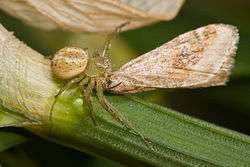Diaea
Diaea is a genus of crab spiders first described by Tamerlan Thorell in 1869.[2] Most species are found in specific locations except for D. livens, which occurs both in the United States and D. dorsata, which has a palearctic distribution.[1] Adults are 5 millimetres (0.20 in) to 7 millimetres (0.28 in) and tend to hide in and around vegetation, especially flowers, where their color allows them to blend in to their surroundings.[3]
| Diaea | |
|---|---|
.jpg) | |
| D. dorsata | |
 | |
| D. evanida | |
| Scientific classification | |
| Kingdom: | Animalia |
| Phylum: | Arthropoda |
| Subphylum: | Chelicerata |
| Class: | Arachnida |
| Order: | Araneae |
| Infraorder: | Araneomorphae |
| Family: | Thomisidae |
| Genus: | Diaea Thorell, 1869[1] |
| Type species | |
| D. dorsata (Fabricius, 1777) | |
| Species | |
|
44, see text | |
Species
As of April 2019 it contains forty-four species:[1]
- Diaea albicincta Pavesi, 1883 — Congo, Ethiopia, East Africa
- Diaea albolimbata L. Koch, 1875 — New Zealand
- Diaea ambara (Urquhart, 1885) — New Zealand
- Diaea bengalensis Biswas & Mazumder, 1981 — India
- Diaea bipunctata Rainbow, 1902 — Vanuatu
- Diaea carangali Barrion & Litsinger, 1995 — Philippines
- Diaea delata Karsch, 1880 — West Africa, Angola
- Diaea doleschalli Hogg, 1915 — New Guinea
- Diaea dorsata (Fabricius, 1777) — Europe, Turkey, Caucasus, Russia (Europe to Middle Siberia), Japan
- Diaea giltayi Roewer, 1938 — New Guinea
- Diaea graphica Simon, 1882 — Yemen
- Diaea gyoja Ono, 1985 — Japan
- Diaea implicata Jézéquel, 1966 — Ivory Coast
- Diaea insignis Thorell, 1877 — Indonesia (Sulawesi)
- Diaea limbata Kulczyński, 1911 — New Guinea
- Diaea livens Simon, 1876 — Southern and Central Europe, Turkey, Caucasus, Iran. Introduced to USA
- Diaea longisetosa Roewer, 1961 — Senegal
- Diaea mikhailovi Zhang, Song & Zhu, 2004 — China
- Diaea mutabilis Kulczyński, 1901 — Ethiopia
- Diaea nakajimai Ono, 1993 — Madagascar
- Diaea ocellata Rainbow, 1898 — New Guinea
- Diaea osmanii Zamani & Marusik, 2017 — Iran
- Diaea papuana Kulczyński, 1911 — New Guinea
- Diaea placata O. Pickard-Cambridge, 1899 — Sri Lanka
- Diaea pougneti Simon, 1885 — India
- Diaea proclivis Simon, 1903 — Equatorial Guinea
- Diaea puncta Karsch, 1884 — Africa
- Diaea rohani Fage, 1923 — Angola
- Diaea rufoannulata Simon, 1880 — New Caledonia
- Diaea semilutea Simon, 1903 — Equatorial Guinea
- Diaea seminola Gertsch, 1939 — USA
- Diaea septempunctata L. Koch, 1874 — New Guinea, Tonga
- Diaea shirleyi Hogg, 1922 — Vietnam
- Diaea simplex Xu, Han & Li, 2008 — China, Hong Kong
- Diaea sphaeroides (Urquhart, 1885) — New Zealand
- Diaea spinosa Keyserling, 1880 — Colombia
- Diaea subdola O. Pickard-Cambridge, 1885 — Russia (Far East), India, Pakistan to Japan
- Diaea suspiciosa O. Pickard-Cambridge, 1885 — Central Asia, Mongolia, China
- Diaea tadtadtinika Barrion & Litsinger, 1995 — Philippines
- Diaea taibeli Caporiacco, 1949 — Kenya
- Diaea terrena Dyal, 1935 — Pakistan
- Diaea tongatabuensis Strand, 1913 — Polynesia
- Diaea viridipes Strand, 1909 — South Africa
- Diaea zonura Thorell, 1892 — Indonesia (Java, Sumatra)
gollark: There are a few "sprinklers".
gollark: AS has a ritual for it I think.
gollark: It also blots out the sun, partly.
gollark: Heav thinks that rifts spawn on the highest available land, which seems right, so we think this should redirect rift spawns to an easy-to-clean area.
gollark: <@151391317740486657> Check out the giant sky shield!
References
- "Gen. Diaea Thorell, 1869". World Spider Catalog. Natural History Museum Bern. Retrieved 2019-04-15.
- Thorell, T. (1869). "On European spiders. Part I. Review of the European genera of spiders, preceded by some observations on zoological nomenclature". Nova Acta Regiae Societatis Scientiarum Upsaliensis. 7 (3): 1–108.
- "Crab spiders: Family Thomisidae". Spiders of Australia. Retrieved 2019-04-15.
This article is issued from Wikipedia. The text is licensed under Creative Commons - Attribution - Sharealike. Additional terms may apply for the media files.